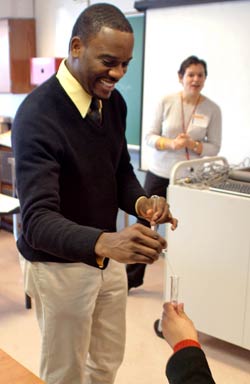Educating Small
Talk about good timing. On the eve of New York City Mayor Michael Bloomberg's announcement that the city will open 52 new small schools next year, more than 600 principals, teachers and other educators were gathering at Fanny Lou Hamer Freedom High School in the Bronx for the third annual Small Schools Conference. Together, they represented some 62 school organizations.
The very next day, New York City Mayor Michael Bloomberg announced that the city will open 52 new small schools next year (see "In the Schools" on the next page).
Perhaps the nation's largest venue for small-school leaders to share strategies for long-term survival, growth and improvement, the conference was organized by the National Academy for Excellent Teaching (NAfET), Teachers College, and its executive director, Douglas Wood.
For Wood, the conference was a watershed moment in the small schools revolution, which he feels is threatened by policymakers' failure to consider the long-term capacity needs of small schools. "The media love to report on shining examples of small schools that are defying the odds by achieving stellar results with poor and underprivileged students, but what we don't often hear about is how these successes often fade when a charismatic founder or leader departs or an overworked staff burns out," he says. "To institutionalize the success of small schools, responsible education reform must fully consider all aspects of organizational capacity: systems, structure, culture, personnel, finance. Our conference arose out of genuine needs expressed by the practitioners with whom we work. These educators on the front lines struggle daily not only with all the normal complexities of teaching, but a myriad of logistical concerns that plague the establishment of any new school."
Attendees at the event heard a stirring opening address by keynote speaker Deborah Meier, founder of Central Park East Secondary School in East Harlem-lauded as a model of urban education reform-and the author of The Power of Their Ideas: Lessons to America from a Small School in Harlem.
"I needn't tell you that small isn't enough," Meier warned her listeners. "It's even more important for fans of small schools to remember that a bad small school can be even more toxic than a bad large one, because there's no place to hide. But small opens the door to forming relationships, and most of us are in need of real-life people, not just the authors of the books we read. We were designed to learn through a form of mimicry and apprenticeship-it's what most mammals do-yet under the current model of schools, children have fewer and fewer relationships with adults as they themselves get closer to adulthood. The football players, the drama students, the students who take advanced placement classes-they have some adult contact. These are the only small schools in our big bad schools. The rest of the students live in peer packs-and the only other teacher they know is the voracious media, which puts more ideas in their heads than we do. Small schools have the power to change that."
During the rest of the event, the participants were able to choose from a variety of workshops on topics that included "Intergenerational Oral History Writing in the Humanities," "Conceptual Physics," "Arts Integration," "Acid Rain: Can We Solve It, Can We Prevent It," "Never Again? Responding to Genocide Since World War II," and "Kid-Talk."
Perhaps a typical example, if there was one, was the teach-in on "Project-Based Math," led by Jonathan Katz, a former math teacher at Pablo Neruda High School in the Bronx. and now a TC doctoral student and staff development advisor for NAfET. Katz led the participants through a number of hands-on exercises, including one in which they were each given a sheet of construction paper, a pair of scissors and some tape, and were then asked to design a container that would hold the maximum amount of popcorn. Following a noisy twenty minutes during which a variety of cylinders, pyramids, boxes, cones and other shapes were hastily constructed (the winner was a somewhat trapezoidal container that held 13 cups of cheddar cheese popcorn), Katz elaborated on his method.
"It's all about whether we can teach kids how to think," he said. "I believe we can, but it's a lengthy process. You get there by letting them raise questions and have those questions be the guiding tool. Let them try things and see what goes wrong. That forces them to strategize, to work backwards through trial and error, to record results and look for patterns." Patterns are especially crucial, he said, "because any mathematical rule arises from some pattern that exists in life."
Katz added that he assigns the popcorn container exercise both before and after teaching his students about volume, radius and other mathematical laws. "You see what they know intuitively, and then later you see whether they can predict outcomes with formulas," he said. "Either way, they're engaged in the work, because it's fun."
NAfET seeks to create models for teaching literacy that can be replicated nationally. It currently operates in 13 New York City public high schools, all in Region 2 the Bronx. NAfET's staff consists of 18 "advisors" (literacy coaches) who provide professional development to teachers and principals on both subject content and teaching methodology, as well as working on whole-development.
Other sponsors of the conference included New York City's Offices of New and Small Schools in Regions 1, 2, and 9; New Visions for Public Schools; the Institute for Literacy Studies at Lehman College; the New York City Mathematics Project; and the New York City Writing Project. The event was funded by Gerry and Lilo Leeds, whose $10 million grant last year also helped establish NAfET.
Published Wednesday, Feb. 23, 2005
